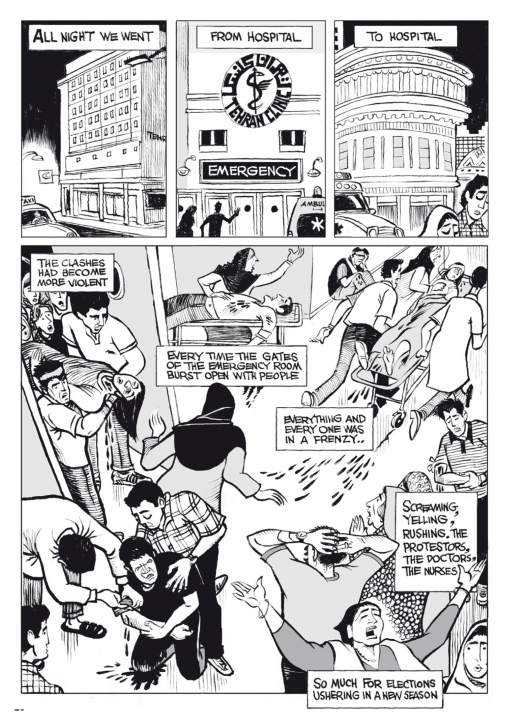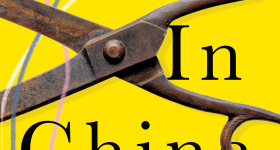In 2009, Mahmoud Ahmedinejad was propped up
as President of Iran by Ayatollah Ali Khameini. It was a move that angered
thousands of Iranians, who took to the streets in protest, demanding a recount
and insisting that the election had been stolen. During this tumultuous time,
hundreds of young men and women who took part in the protests at Freedom Square
went missing and later, turned up dead.
Set against this backdrop, Zahra's
Paradise is a fictionalized account about the search for a young university
student, Mehdi, who fails to come home one night after participating in the
protests. It is also the story of his mother, Zahra, and brother, Hassan, as
they navigate through Iran's labyrinthine bureaucracy in an attempt to track
him down. The book is written and illustrated pseudonymously by 'Amir' and
'Khalil' -- an Iranian American activist and an Algerian artist respectively --
and is packed with literal and figurative criticisms against the Islamic
Revolution, Ahmedinejad, and the Ayatollah. They are depicted variously as
vultures, scarecrows, and at one point, even as cannibalistic machines intent on
“feeding their morgues.” So, it comes as no surprise that both the author and
illustrator have chosen the protection of pseudonyms.
The search for Mehdi is narrated largely
though his brother Hassan's blog entries, beginning on June 16, 2009. Their
search takes Hassan and his mother, Zahra, from Freedom Square, Mehdi's last
known location, to the hellish corridors of hospitals full of the wounded and
dying, to Evin prison where dissidents of the regime are sent and finally to
the cemetery -- Zahra's Paradise, from which the book gets its title. When they
are unable to find Mehdi anywhere, Hassan takes it upon himself to challenge
the regime by starting his blog. Hassan writes, “They want to wipe Mehdi off
the face of time, confiscate the sound of his name, the promise of his return.
There can be no witness.” He continues in the next panel, “Now it’s my turn to
publish. I'll test the power of my blog against their press.”
With that Hassan enters the world of the resistance,
partnering with a local copy shop owner to print and distribute flyers with
Mehdi's details. But apart from the moral outrage at the regime's systematic
silencing of the protests, Hassan and Zahra don't have much. That is, until
Hassan runs into the charming Sepideh who also happens to be the mistress of a
high ranking official in the Iranian government. With Sepideh's help, Hassan is
able to delve into a deeper investigation of his brother's disappearance.
In one of the most startling splash pages
in the book, the Islamic Republic's judiciary is depicted as a factory where
rows upon rows of prisoners are fed by means of serpentine conveyor belts into
the open mouths of the Ayatollahs Khameini and Khomeini. The words “[i]n the
name of God, the Merciful, the Compassionate ...” spill out of Khomeini's
mouth. This visual alone tells the entire story of prisoners' journeys from
arrest to torture to being publicly hanged from cranes in the town square. The crane hangings are disturbing on several levels as
even the author points out in his post-script, “How did the crane supplant the
scales as the symbol of God's justice?” In fact, the
story is not so much about finding Mehdi as it is about exposing what happens
in Iran to men and women like Mehdi. In a country where much of the media is
controlled and foreign media is banned, Zahra's Paradise attempts to
address the situation, albeit under the guise of fiction.
Despite a simple black and white color
scheme, Khalil's art is arresting. The artist's ability to create emotional and
expressive faces adds depth to the author's pithy writing. The splash pages are
so intricately detailed and can be viewed as mini-chapters in themselves. The
panels also periodically break out of the regular comic-book format, most
notably early on with an M.C. Escher-esque visual where Hassan deliriously
searches for Mehdi.
As a writer, Amir paints equally evocative
portraits of people and draws us into their lives seamlessly. With these deeply personal stories and the political and cultural realities of
modern Iran intertwining, it is difficult to view the events, fictional or not, without
becoming emotionally vested in the fate of the characters. A particularly heart-rending moment arrives when
Hassan finds his mother in Mehdi's room. When he asks her what she's doing
there, she replies, “I brought Mehdi's glass of water.” When Hassan points out
that she's “been doing that every night...”, she can only say, “You never know
when he'll be back.” It is through his attention to even the littlest detail
that Amir manages to humanize the characters, making them jump off the page until
they become as real as the reader themselves.

For many in the Western world who view Iran
as a one-dimensional Islamic republic, this book offers a glimpse of an Iran
that is socially, culturally and religiously complex. Take Mehdi, for example.
Here is a young man who was last seen wearing a Bob Marley T-shirt, wearing a
'Zizou' pendant idolizing Zinadine Zidane, the captain of the French soccer
team, and tweeting his friends at Freedom Square. But it is the portrayal of
Sepideh, Hassan's eventual partner-in-crime, that will shatter images of Iranian women
as burqa-clad, docile and voiceless individuals. Sepideh is neither docile not
voiceless, as she brazenly seduces and makes love to her married boyfriend
Mansoor. Entering a "temporary marriage" with Mansoor, Sepideh flouts social
and moral taboos. The author informs us in a footnote that “In Iran, temporary
marriage is a legal contract between a man (married or not) and an unmarried woman
who is compensated.”
Finally, while the novel is fiction, the
back of the book offers short histories about the 2009 elections as well as
thirteen pages with the names of all those who lost their lives for protesting
against the Ayatollah. In the vein of Marjane Sartrapi's Persepolis and Art Speigelman's Maus,
Zahra's Paradise is quite possibly one of the most important graphic
novels of our times.
* * *
Anisha
Sridhar is a journalist and writer who writes all day and sometimes gets paid for
it.









Comments